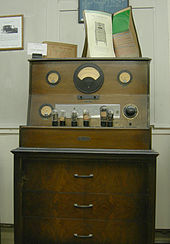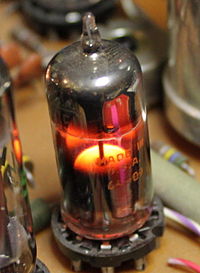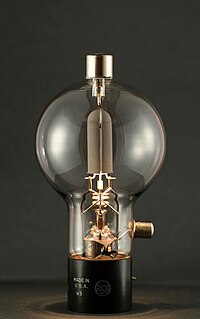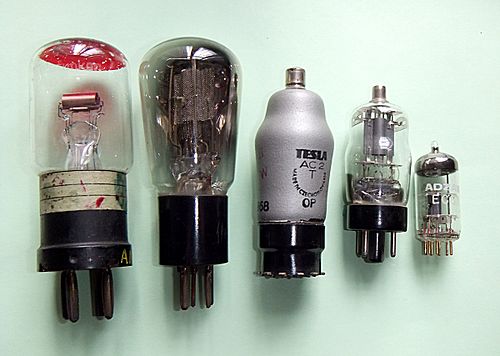A considerable amount of heat is produced when tubes operate, both from the filament (heater) but also from the stream of electrons bombarding the plate. The requirements for heat removal can significantly change the appearance of high-power vacuum tubes. Although the miniature tube style became predominant in consumer

The anode (plate) of this transmitting triode has been designed to dissipate up to 500W of heat
equipment, high power audio amplifiers and rectifiers would still require the larger "octal" style of enclosure. Transmitting tubes could be much larger still.
Most tubes produce heat from two sources during operation. The first source is the filament or heater. Some tubes contain a
directly heated cathode. This is a filament similar to an incandescent electric lamp; some types glow brightly like a lamp, but most glow a dim orange-red. The "bright emitter" types possess a tungsten filament alloyed with 1–3 % thorium which reduces the work function of the metal, giving it the ability to emit sufficient electrons at about 2000 degrees Celsius. The "dull emitter" types also possess a tungsten filament but it is coated in a mixture of calcium, strontium and barium oxides, which emit electrons easily at much lower temperatures due to a monolayer of mixed alkali earth metals coating the tungsten; these only reach 800–1000 degrees Celsius.
The second form of cathode is the
indirectly heated form which usually consists of a nickel cylinder, coated on the outside with the same strontium, calcium, barium oxide mix used in the "dull emitter" directly heated types. Inside the cylinder is a tungsten filament to heat it. This filament is usually uncoiled and coated in a layer of alumina (aluminium oxide) in order to insulate it electrically from the actual cathode. This form of construction allows for a much greater electron emitting area and allows the cathode to be held at a potential difference, typically 150 volts more positive than the heater or 50 volts more negative than the heater. For small-signal tubes such as used in radio receivers, heaters consume between 50 mW and 5 watts, (directly heated), or between 500 mW and 8 watts for indirectly heated types. Thus even a small signal amplifier might consume a watt of power just to warm its heater, compared to the milliwatts (or less) that a modern semiconductor amplifier would require for the same function. Even in power amplifiers the filament power may be responsible for an appreciable reduction in efficiency.
The second source of heat is generated at the plate (anode), as electrons accelerated by its high voltage strike it, depositing their kinetic energy there and raising its temperature. In tubes used in power amplifiers or transmitter output stages, this source of heat will far exceed the power due to the cathode heater. The plates of improperly operated or overloaded beam power tubes can sometimes become visibly red hot; this should never occur under normal operation of consumer electronics and is a precursor to tube failure.
Heat escapes the device by black body radiation from the anode (plate) as infrared radiation. Convection is not possible in most tubes since the anode is surrounded by vacuum. Considerations of heat removal can affect the overall appearance of some tubes. The anode is often treated to make its surface less shiny and darker in the infrared (see black body radiator). The screen grid may also generate considerable heat, which is radiated toward the plate which must reradiate that additional heat along with the heat it generates itself. Limits to screen grid dissipation, in addition to plate dissipation, are listed for power devices. If these are exceeded then tube failure is likely.
Tubes used as power amplifier stages for radio transmitters may have additional heat exchangers, cooling fans, radiator fins, or other measures to improve heat transfer at the anode (plate). High power transmitting tubes may have the surface of their anodes external to the tube, allowing for water cooling or evaporative cooling. Such a water cooling system must be electrically isolated to withstand the high voltage present on the anode.
Tubes which generate rather little heat, such as the 1.4 volt filament directly heated tubes designed for use in battery powered equipment, often have shiny metal anodes. 1T4, 1R5 and 1A7 are examples. Gas filled tubes such as thyratrons may also use a shiny metal anode since the gas present inside the tube allows for convection of heat from the anode to the glass enclosure.
The outer electrode in most tubes is the anode (plate). Some small signal types, such as sharp and remote cut-off R.F. and A.F. pentodes and some pentagrid converters have a shield fitted around all the electrodes enclosing the anode. This shield is sometimes a solid metal sheet, treated to make it dull and gray so that it can itself reradiate heat generated from within. Sometimes it is fabricated from expanded metal mesh, acting as a Faraday cage but allowing sufficient infrared radiation from the anode to escape. Types 6BX6/EF80 and 6BK8/EF86 are typical examples of this shielded type using expanded mesh. Types 6AU6/EF94 and 6BE6/EK90 are examples which use a gray sheet metal cylindrical shield.

 Getter in opened tube; silvery deposit from getterhelp free any remaining gases from the metal parts. The tube is then sealed and the getter is heated to a high temperature, again by radio frequency induction heating. This causes some material from the getter to
Getter in opened tube; silvery deposit from getterhelp free any remaining gases from the metal parts. The tube is then sealed and the getter is heated to a high temperature, again by radio frequency induction heating. This causes some material from the getter to 
 Tube tester manufactured in 193evaporate, reacting with any residual gases and usually leaving a silver-colored metallic deposit on the inside
Tube tester manufactured in 193evaporate, reacting with any residual gases and usually leaving a silver-colored metallic deposit on the inside 
 Voltage regulator tube in operation. Low pressure gas within tube glows due to current flow.of the envelope of the tube. The getter continues to absorb small amounts of gas that may leak into the tube
Voltage regulator tube in operation. Low pressure gas within tube glows due to current flow.of the envelope of the tube. The getter continues to absorb small amounts of gas that may leak into the tube 
 70 watt tube audio amplifier selling for $2,680[23] in 2011, about 10 times the price of a comparable model using transistors.[24during its working life. If a tube develops a serious leak in the envelope, this deposit turns a white color as it reacts with atmospheric oxygen. Large transmitting and specialized tubes often use more exotic getter materials, such as zirconium. Early gettered tubes used phosphorus based getters and these tubes are easily identifiable, as the phosphorus leaves a characteristic orange or rainbow deposit on the glass. The use of phosphorus was short-lived and was quickly replaced by the superior barium getters. Unlike the barium getters, the phosphorus did not absorb any further gases once it had fired.
70 watt tube audio amplifier selling for $2,680[23] in 2011, about 10 times the price of a comparable model using transistors.[24during its working life. If a tube develops a serious leak in the envelope, this deposit turns a white color as it reacts with atmospheric oxygen. Large transmitting and specialized tubes often use more exotic getter materials, such as zirconium. Early gettered tubes used phosphorus based getters and these tubes are easily identifiable, as the phosphorus leaves a characteristic orange or rainbow deposit on the glass. The use of phosphorus was short-lived and was quickly replaced by the superior barium getters. Unlike the barium getters, the phosphorus did not absorb any further gases once it had fired.
















